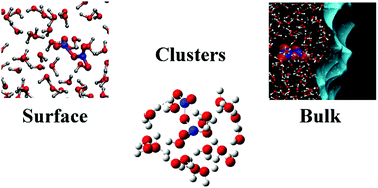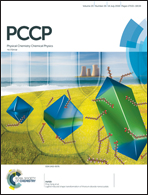N2O5 at water surfaces: binding forces, charge separation, energy accommodation and atmospheric implications†
Abstract
Interactions of N2O5 with water media are of great importance in atmospheric chemistry and have been the topic of extensive research for over two decades. Nevertheless, many physical and chemical properties of N2O5 at the surface or in bulk water are unknown or not microscopically understood. This study presents extensive new results on the physical properties of N2O5 in water and at the surface of water, with a focus on their microscopic basis. The main results are obtained using ab initio molecular dynamics and calculations of a potential of mean force. These include: (1) collisions of N2O5 with water at 300 K lead to trapping at the surface for at least 20 ps and with 95% probability. (2) During that time, there is no N2O5 hydrolysis, evaporation, or entry into the bulk. (3) Charge separation between the NO2 and NO3 groups of N2O5, fluctuates significantly with time. (4) Energy accommodation of the colliding N2O5 at the surface takes place within picoseconds. (5) The binding energy of N2O5 to a nanosize amorphous ice particle at 0 K is on the order of 15 kcal mol−1 for the main surface site. N2O5 binding to the cluster is due to one weak hydrogen bond and to interactions between partial charges on the N2O5 and on water. (6) The free-energy profile was calculated for transporting N2O5 from the gas phase through the interface and into bulk water. The corresponding concentration profile exhibits a propensity for N2O5 at the aqueous surface. The free energy barrier for entry from the surface into the bulk was determined to be 1.8 kcal mol−1. These findings are used to interpret recent experiments. We conclude with implications of this study for atmospheric chemistry.



 Please wait while we load your content...
Please wait while we load your content...